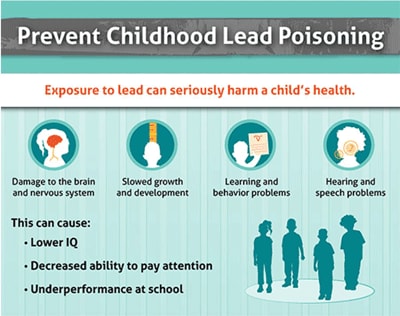"Childhood lead poisoning is 100% preventable. The key is to keep children from coming into contact with lead. Learn how to prevent children’s exposure to lead.
Exposure to lead can seriously harm a child’s health, including damage to the brain and nervous system, slowed growth and development, learning and behavior problems, and hearing and speech problems. No safe blood lead level in children has been identified. There are many ways parents can reduce children’s exposure to lead before they are harmed. Lead hazards in a child’s environment must be identified and controlled or removed safely. Lead is invisible to the naked eye and has no smell.
Common Ways Children Can Come in Contact with Lead
Young children often put toys, fingers, and other objects in their mouth as part of their normal development. This may put them in contact with lead paint or dust.
One common way children can be exposed to lead is through contact with chips and dust in buildings and homes from old lead paint. Children can be directly exposed to lead if they swallow chipped pieces of leaded paint. But their exposure is more common from swallowing house dust or soil contaminated by leaded paint. This happens when lead paint peels and cracks, resulting in tiny bits of lead dust that embed in the dust and soil in and around homes; for example, when leaded paint is old or worn, or is subject to constant rubbing (as on doors and windowsills and wells). In addition, lead can be scattered when paint is disturbed during building destruction or remodeling, paint removal, or preparation of painted surfaces for repainting.

Exposure to lead can seriously harm a child’s health, including damage to the brain and nervous system, slowed growth and development, learning and behavior problems, and hearing and speech problems.
Lead paint or dust are not the only ways children can come into contact with lead. Other sources include:
- traditional home health remedies such as azarcon and greta, which are used for upset stomach or indigestion in the Hispanic community
- imported candy and candy wrappers
- imported toys and toy jewelry
- imported cosmetics
- pottery and ceramics
- drinking water contaminated by lead leaching from lead pipes, solder, brass fixtures, or valves
- consumer products, including tea kettles and vinyl miniblinds,,"
Lead poisoning
